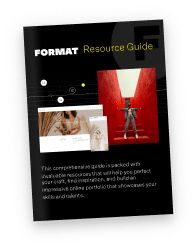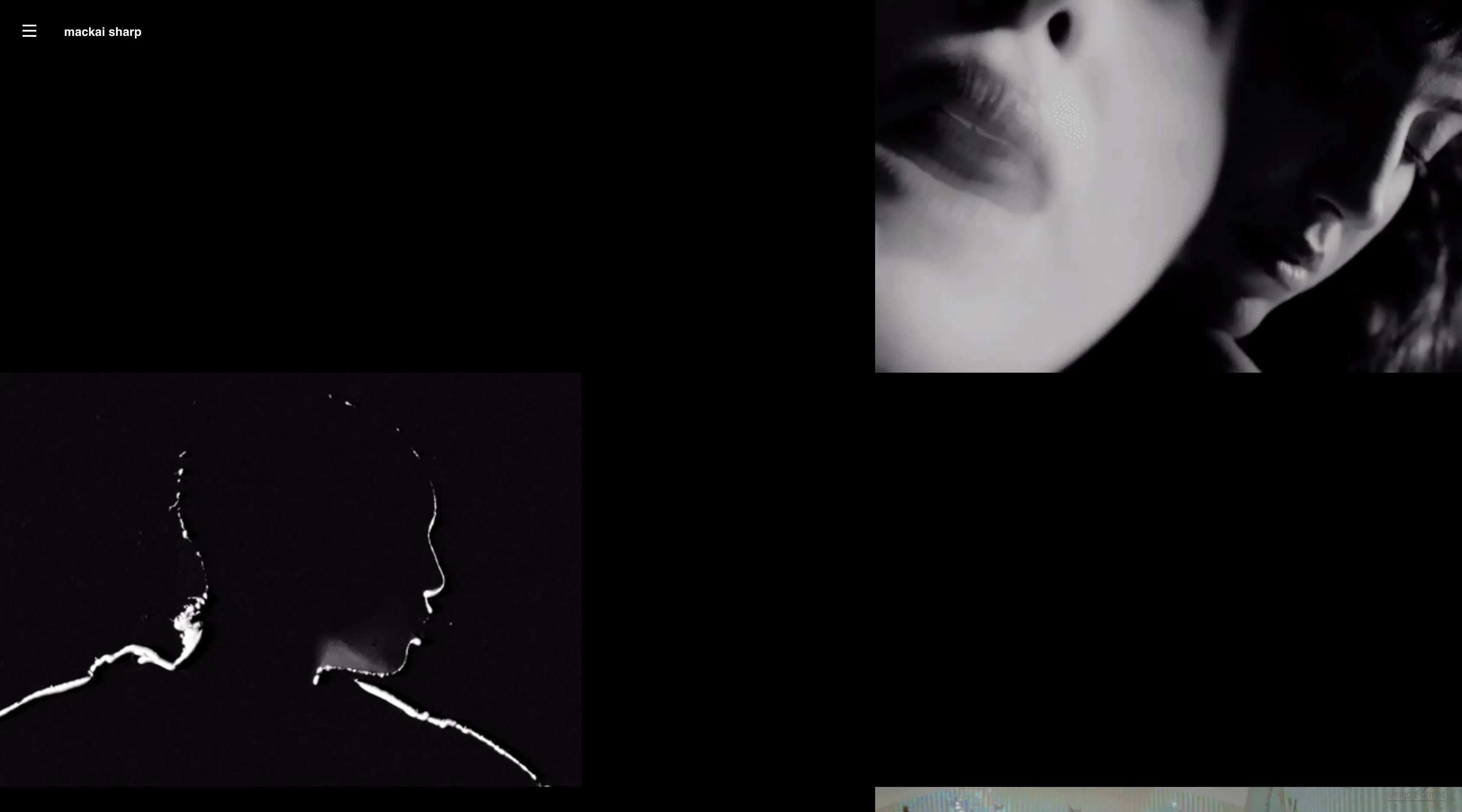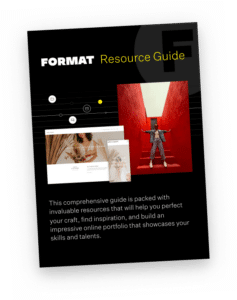A identidade da sua marca é uma ferramenta crucial para estabelecer quem você é e como seu público e clientes se relacionam com você. A aparência do portfólio do seu site ou da marca da sua empresa - desde o logotipo e a tipografia até a embalagem e o estilo de experiência do cliente que você escolher - pode atrair e influenciar colecionadores, clientes e consumidores.
Quanto mais coesa e consistente for a identidade da sua marca, mais fácil será para as pessoas entenderem e se conectarem com a sua empresa. Ao criar uma identidade de marca, você precisa selecionar cuidadosamente os recursos visuais e o conteúdo para representá-lo e manter um estilo e um tom consistentes para apoiar a marca da sua empresa.
Não importa se você é um freelancer que deseja criar um site para se promover ou um designer de moda que apresenta sua nova linha de roupas, a criação de uma identidade de marca deve ser a primeira etapa da jornada de todo criativo.
O que é necessário para criar uma identidade de marca?
Isso varia de acordo com o seu setor e o trabalho que você está fazendo, o produto que está fabricando ou o serviço que está prestando, mas, de modo geral, a identidade da marca é uma combinação dos seguintes aspectos:
As palavras:
- Propósito e posicionamento claros
- Nome da marca
- Tom e voz consistentes
O visual:
- Logotipo e gráficos
- Tipografia
- Paleta de cores
- Site do portfólio
- Design de interiores (seu estúdio, loja ou escritório)
- Embalagem
A presença na mídia social:
- Instagram e Instagram Stories
- Snapchat
- Tumblr
- Facebook Live
- YouTube
- Bluesky
- Twitter (X)
Você está pronto para criar sua marca? Vamos começar!
Transmita um propósito e um posicionamento claros
Essa é a etapa mais importante na criação de uma identidade de marca; seu propósito, valores, metas e público-alvo devem estar claros desde o início. Esse processo pode ser longo e desafiador e requer muita reflexão e pesquisa.
Por quê? Um criador de sucesso sabe, por dentro e por fora, quem ele é e quem está tentando alcançar. Toda decisão de marca deve ser tomada tendo em mente seus clientes e consumidores em potencial. Por exemplo, um logotipo voltado para os millennials seria muito diferente de um logotipo voltado para os zoomers. As cores, a fonte e a linguagem devem ser planejadas para falar com seu público principal. Lembre-se, quando se trata de estratégia de marca, se você tentar atingir todos, acabará não atingindo ninguém.
Algumas perguntas úteis que você pode fazer a si mesmo durante o processo:
- Como você visualizaria sua própria personalidade? Que cores você associa a si mesmo e ao seu trabalho? Você está na moda e é moderno, ou é clássico e profissional? Descobrir que tipo de pessoa você é é fundamental para determinar como criar sua marca.
- Qual é a minha proposta de valor? O que você está oferecendo ao seu público em troca do tempo, dinheiro ou compromisso dele? Se você está iniciando um canal de bricolagem no YouTube, por exemplo, sua proposta de valor pode ser vídeos semanais que ensinem como fazer upcycle de móveis com um orçamento limitado.
- Quem é meu concorrente? Pesquise os possíveis concorrentes - toda marca os tem. Mesmo que seu produto ou serviço seja revolucionário e único, você ainda está competindo pelo tempo do consumidor e terá concorrentes que também estão atrás desse bem precioso. Encontre uma maneira exclusiva de definir sua marca que diferencie você.
Determine o nome da sua marca e o slogan
Se você estiver criando uma marca para si mesmo e para suas próprias habilidades e talentos - digamos que você seja um ilustrador ou designer gráfico freelancer -, seu próprio nome servirá! Se a sua marca tiver mais de um fundador ou se você quiser apenas um nome original, pense no que deseja realizar com a marca. Você quer que ela seja direta e descritiva, ou inventiva e atraente?
Evite erros como nomes muito longos ou difíceis de soletrar, ou que possam causar confusão ao pesquisar por serem muito comuns.
Tenha em mente os domínios do site e os perfis de mídia social, pois você precisará comprar um domínio de site e reivindicar todos os identificadores de mídia social para o nome da sua marca. Identificadores de mídia social inconsistentes podem confundir seu público e dificultar a localização de você.
O brainstorming nunca deve ser feito sozinho, especialmente quando você está criando uma marca! Recrute amigos, familiares e faça uma pesquisa com o maior número de pessoas que você puder. Jogue jogos de associação de palavras para que você tenha novas ideias de nomes, slogans ou slogans - tudo isso ajudará na visualização da identidade da sua marca.
Antes de ir longe demais ou se apegar demais a um nome, domínio personalizado ou até mesmo a um logotipo, verifique primeiro se ele já foi usado. Não se desespere, se for o caso, atualize-se e volte a ter novas ideias.

Crie um ótimo logotipo
O logotipo é o elemento visual central da identidade de sua marca. Ele é usado no seu site, nas comunicações com clientes e consumidores, nas mídias sociais - em todos os lugares. Por isso, é muito importante que você crie um logotipo que atenda a esses critérios fundamentais:
- Atemporal
- Simples
- Memorável
- Versátil
- Apropriado
Muitas pessoas acham que o logotipo é a parte mais importante da criação de uma identidade de marca. (Basta pensar nos arcos dourados do McDonald's; é o logotipo mais reconhecido do mundo, desempenhando um papel fundamental em sua imagem de marca desde a década de 1940!) Um logotipo é Você pode ter certeza de que a segurança é importante, mas ela é apenas uma parte do pacote geral.
Você quer que seu logotipo seja uma imagem? Ou o nome de sua marca? Ou uma combinação dos dois? Qual é o estilo que você quer?
Aqui você encontra algumas inspirações sobre como criar o logotipo perfeito para você com muitos exemplos excelentes.
Escolha a tipografia correta
A tipografia pode parecer um componente simples da identidade geral da marca, mas pode ser difícil encontrar a fonte certa para se adequar à sua marca e transmitir sua história.
Cada fonte tem sua própria personalidade, mesmo para o olho não treinado. Com uma variedade tão grande para você escolher, há algumas coisas que você deve ter em mente:
- Evite as fontes sofisticadas - Comic Sans, Papiro...
- Use de duas a três famílias de fontes para obter uma aparência coesa: uma para a fonte de exibição e uma ou duas para o corpo.
- Certifique-se de que seja facilmente legível - Acima de tudo, uma boa tipografia proporciona a melhor experiência possível ao usuário.
- A fonte corresponde ao seu público?
- Você não pode errar com um visual mais atemporal. Ocasionalmente, certas fontes começam a se tornar tendência na cultura pop. Se você quiser que a identidade da sua marca tenha uma vida útil mais longa do que um ciclo de álbuns, evite fontes da moda e opte por fontes clássicas, limpas e atemporais.
Lembre-se: Quando se trata de desenvolvimento de marca, a tipografia bem escolhida e consistente é uma parte importante da comunicação coesa e do reconhecimento da marca.
Escolha sua paleta de cores
Você está começando a entender agora, certo? (Os elementos visuais são fundamentais para transmitir significado e emoção, e a cor é um elemento de peso nessa fórmula. O verde é uma cor natural, fresca, que representa crescimento, enquanto o vermelho transmite urgência, paixão e entusiasmo. As cores que você escolhe para a sua marca devem refletir o propósito e a intenção da sua marca.
Limite-se a:
- Quais valores ou atributos você deseja representar? Quais tons refletem melhor sua personalidade ou empresa? Se o seu nicho for, por exemplo, fotografia de recém-nascidos, cores pastéis suaves que representam juventude e serenidade seriam mais adequadas do que um fuschia selvagem ou um oliva sombrio.
- Que cores geralmente estão associadas ao seu gênero de trabalho? Por exemplo, alimentos e finanças geralmente são associados a tons de verde.
- Que combinação é esteticamente agradável e complementar? Ao expressar sua história-imagem sucinta, o que é contraste demais e o que não é suficiente?
Esses paletas de cores únicas e memoráveis podem inspirar você e ajudá-lo a progredir por conta própria.
Selecione a iconografia, os gráficos e as imagens corretos
Ícones, símbolos visuais e fotografias formam uma grande parte do desenvolvimento da marca.
Você pode notar que as grandes marcas que exibem fotos biográficas para uso interno ou externo geralmente compartilham um visual coeso. Diretrizes de estilo rígidas não são incomuns para empresas esteticamente conscientes.
Criar o seu próprio manterá você no rumo certo ao criar ou introduzir novos elementos ou conteúdo.

Crie seu site
Seu website é o hub central para as principais informações sobre sua marca. Aqui você tem a oportunidade de incluir mais detalhes do que faria nas mídias sociais, fornecendo uma biografia completa e amostras de trabalho, além de links para todas as suas plataformas afiliadas.
O tom do seu site deve ser sempre autêntico. Se você quiser aumentar o tráfego e estiver pensando em trazer criadores de conteúdo externos (para escrever entradas de blog, por exemplo), certifique-se de que eles recebam treinamento extensivo não apenas sobre os fundamentos da proposta de valor e do posicionamento de mercado da sua empresa, mas também sobre o tom e a voz da marca da sua empresa. Seu público sempre saberá quando o conteúdo não parecer fiel à identidade da sua marca.
Seu site é o seu portfólio on-lineO layout e o design são tão importantes quanto as amostras exibidas do seu trabalho. Enquanto você Criando seu site Ao escolher um tema, pense na página inicial do seu site como se fosse seu cartão de visitas ou currículo - ela se destaca? É fácil encontrar e analisar suas principais realizações? Ela transmite seu estilo e personalidade?
Você usa vários chapéus e não tem certeza de como criar sua marca? Se você for um designer gráfico/ilustrador/desenvolvedor front-end, por exemplo, não se preocupe: essas habilidades estão relacionadas o suficiente para compartilhar o mesmo website, já que o mercado provavelmente é o mesmo. Mas certifique-se de agrupar suas amostras de trabalho por profissão; a organização adequada do seu conteúdo garante que o público certo encontre exatamente o que está procurando.
Milhares de personalizações para combinar com seu estilo exclusivo.
Personalize seu site para contar a história de sua marca. O Format tem quase 100 modelos que oferecem milhares de variáveis de design.
Crie uma ótima sinalização
Se a sua marca tiver uma loja de varejo ou um estúdio com hora marcada, a sinalização será importante para promover a marca da sua empresa. A sinalização externa chique, incluindo gráficos de vinil para janelas e placas na calçada, direciona o tráfego. Certifique-se de incorporar seu logotipo padrão, a tipografia e a paleta de cores em toda a sinalização para garantir que sua marca seja consistente e atraente, solidificando-a na mente dos clientes.
E, se você tiver a oportunidade de vender sua arte em uma feira ou em uma loja pop-up, não se esqueça de colocar alguns cartazes para atrair as pessoas!
Marque uma linda decoração
Na era da mídia social, a decoração está desempenhando um papel ainda maior no marketing da marca. Os clientes fazem propaganda gratuita toda vez que tiram uma foto em sua loja ou estúdio para publicar nas mídias sociais, o que facilita o desenvolvimento da marca.
Isso também se aplica se você for um criador de conteúdo e trabalhar em frente a cenários, em um estúdio ou em casa. O que você mostra diz muito sobre você e pode prejudicar ou contribuir para a identidade da sua marca.
Como criar sua própria marca nas mídias sociais: Conheça a voz de sua marca
A marca nas mídias sociais depende muito da voz, portanto, você precisa conhecer bem a sua própria voz e, ao publicar qualquer conteúdo, perguntar-se "isso soa como eu?".
É importante que você escolha as plataformas que fazem mais sentido para sua marca. Cada plataforma de mídia social tem um grupo demográfico específico, geralmente dividido por idade.
O tipo de linguagem que você usa nas mídias sociais - o texto das legendas do Instagram, dos Tweets e das publicações do Facebook - deve falar diretamente com o seu público.
Encontrar essa voz pode ser complicado, portanto, tente sempre ter em mente essas perguntas-chave:
- Quem é o seu público-alvo? A idade demográfica dirá a você se o uso de gírias, GIFs e referências à cultura pop são apropriados ou não, e quais deles repercutirão entre eles.
- Qual é a cultura da sua marca? Isso remete aos seus valores essenciais.
- Se a sua marca fosse representada por um personagem, quem seria? Pense em seu representante ideal e em como ele se comunicaria.
- Você já realizou uma pesquisa de mercado? Você já fez pesquisa de mercado? percepções mostrou que a honestidade e a autenticidade são as características mais importantes da voz de uma marca na mídia social.
- Quem está falando pela sua marca? É só você ou será uma equipe de redatores de conteúdo? Pergunte a você mesmo:
- Usamos jargões sociais, gírias e coloquialismos?
- Falamos francamente sobre os assuntos ou somos mais diplomáticos?
- Temos uma estratégia clara de atendimento ao cliente em vigor?
- Você usa hashtags ou emojis regularmente?
É importante estabelecer regras básicas sobre como a sua marca usa a voz, para que o conteúdo de todos os redatores possa ser consistente.
Use estas estratégias de desenvolvimento de marca
Você pode ter um excelente guia de identidade de marca - um logotipo atraente, uma bela paleta de cores, um tipo de letra contemporâneo, um site incrível e uma voz clara como cristal. Como você tira o máximo proveito disso nas mídias sociais?
Aqui estão algumas coisas que você deve e não deve fazer em relação à marca:
- Faça Envolva-se com frequência! O envolvimento promove o feedback e gera uma experiência positiva para o cliente. Curta os comentários positivos, responda às perguntas e trate todos os comentários negativos ou preocupações com um tom amigável, educado e construtivo. A publicação consistente é fundamental - nada mata o tráfego mais rapidamente do que a falta de conteúdo novo.
- Não faça isso Procure grandes marcas estabelecidas para obter um modelo de mídia social - marcas como a Adidas podem ter seu slogan como biografia porque já são bem conhecidas. Sua biografia no Twitter e no Instagram deve ser informativa, mas curta e direta, descrevendo o que sua marca tem a oferecer.
- Faça invista em software de mídia social. Há dezenas de programas e ferramentas disponíveis para ajudar você a gerar uma programação automatizada de publicação de conteúdo, para atrair o público no momento certo e aumentar o envolvimento e o feedback. Há muitas plataformas que oferecem testes gratuitos de suas ferramentas de gerenciamento, publicação e análise de mídia social para medir e monitorar seu sucesso.
- Não faça isso Explique demais. Mantenha suas legendas curtas e limite o uso de hashtags a uma por publicação (se for o caso). Se você encher sua linha do tempo com muitas hashtags e legendas longas, você se desconectará do seu público. Estudos demonstraram que nossa capacidade média de atenção é de aproximadamente 7 segundos - quase o mesmo que um peixinho dourado.
- Faça Mantenha seus recursos visuais consistentes. Seu logotipo e sua paleta de cores devem ser refletidos em suas mídias sociais, especialmente quando se trata de uma plataforma com muitos recursos visuais, como o Instagram. Sua foto de perfil/avatar deve ser o seu logotipo. Mantenha todos os recursos visuais publicados consistentes, cortando-os ou filtrando-os da mesma maneira.
Dê uma olhada na maneira como o popular tatuador @johnboytattoo Você notará que todas as imagens dele têm uma sensação semelhante com um estilo distinto. Se você tiver a oportunidade de ser criativo em sua galeria, aproveite-a! Isso ajudará no reconhecimento de sua marca.

Utilize um guia de estilo da marca
Uma parte importante da implementação e da construção da identidade de sua marca é a criação de um guia de estilo de marca. Esse livreto perfeitamente embalado exibirá todos os seus recursos visuais e explicará a voz, o tom e os valores da sua marca. Preencha-o com exemplos e casos de uso, para que o guia de estilo possa funcionar como uma diretriz para todas as suas necessidades de marca.
Ao trabalhar com colaboradores, isso é imprescindível para que você esteja na mesma página. Se você tiver feito uma pesquisa de mercado, este também é um bom lugar para adicionar suas descobertas e explicar como elas informam sua abordagem.
Aproveite todas as oportunidades de associação de marcas, e o resultado final será um guia de identidade de marca sólido. O investimento inicial em abordar esse assunto de forma cuidadosa, completa e criativa economizará tempo para você no futuro.
Agora que você tem as ferramentas de que precisa para começar a criar sua marca, comece a divulgá-la! Se você está pronto para começar a criar seu site, temos muitos modelos incríveis para que você possa criar seu site sem esforço. Mostre seu trabalho.
Você quer ainda mais dicas sobre como criar sua marca? Dê uma olhada nestas dicas:
13 Qualidades de todo site de portfólio bem projetado
Um guia para a estratégia de mídia social para seu negócio criativo
Como iniciar seu próprio podcast: Um guia para criadores












